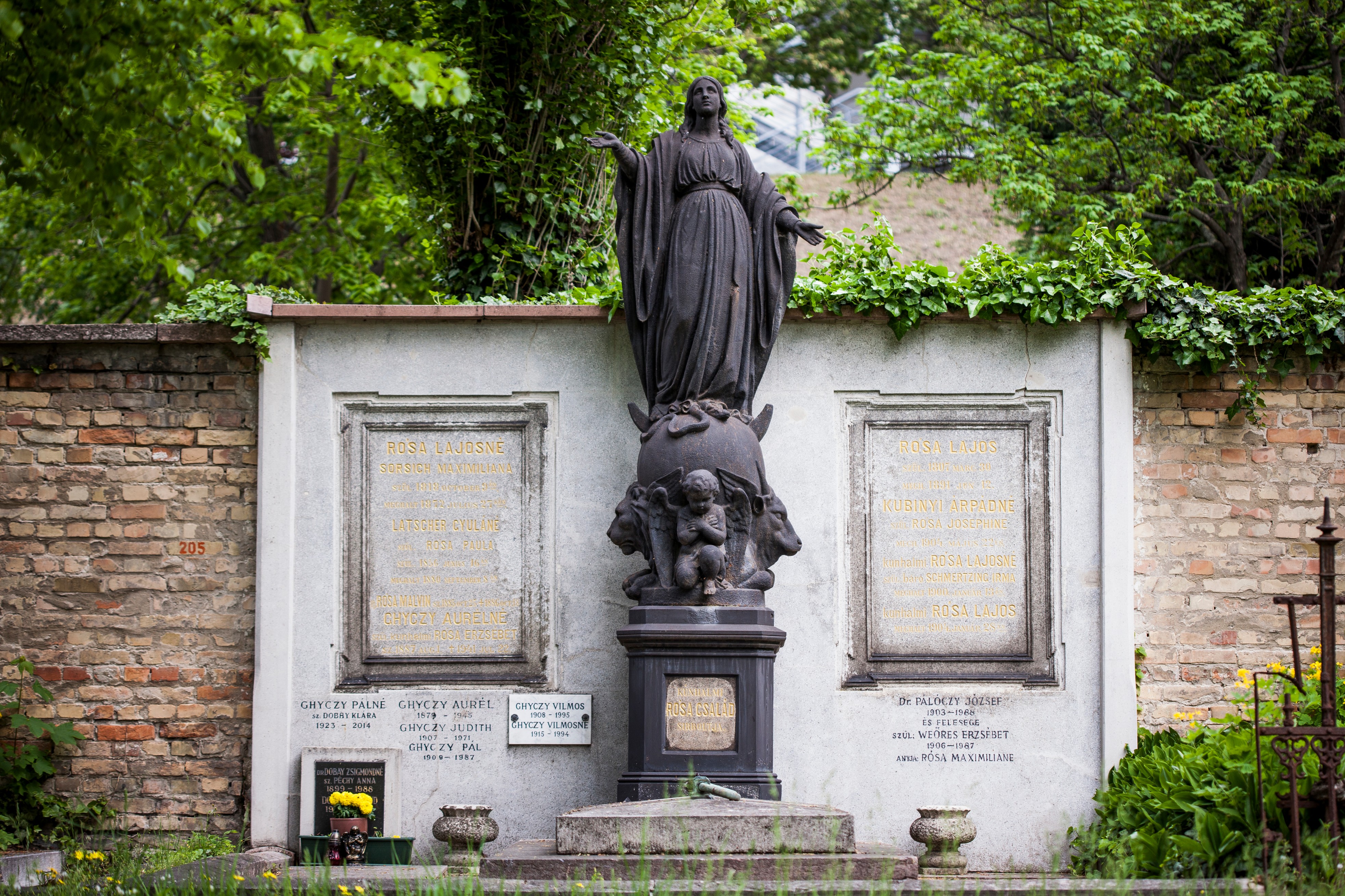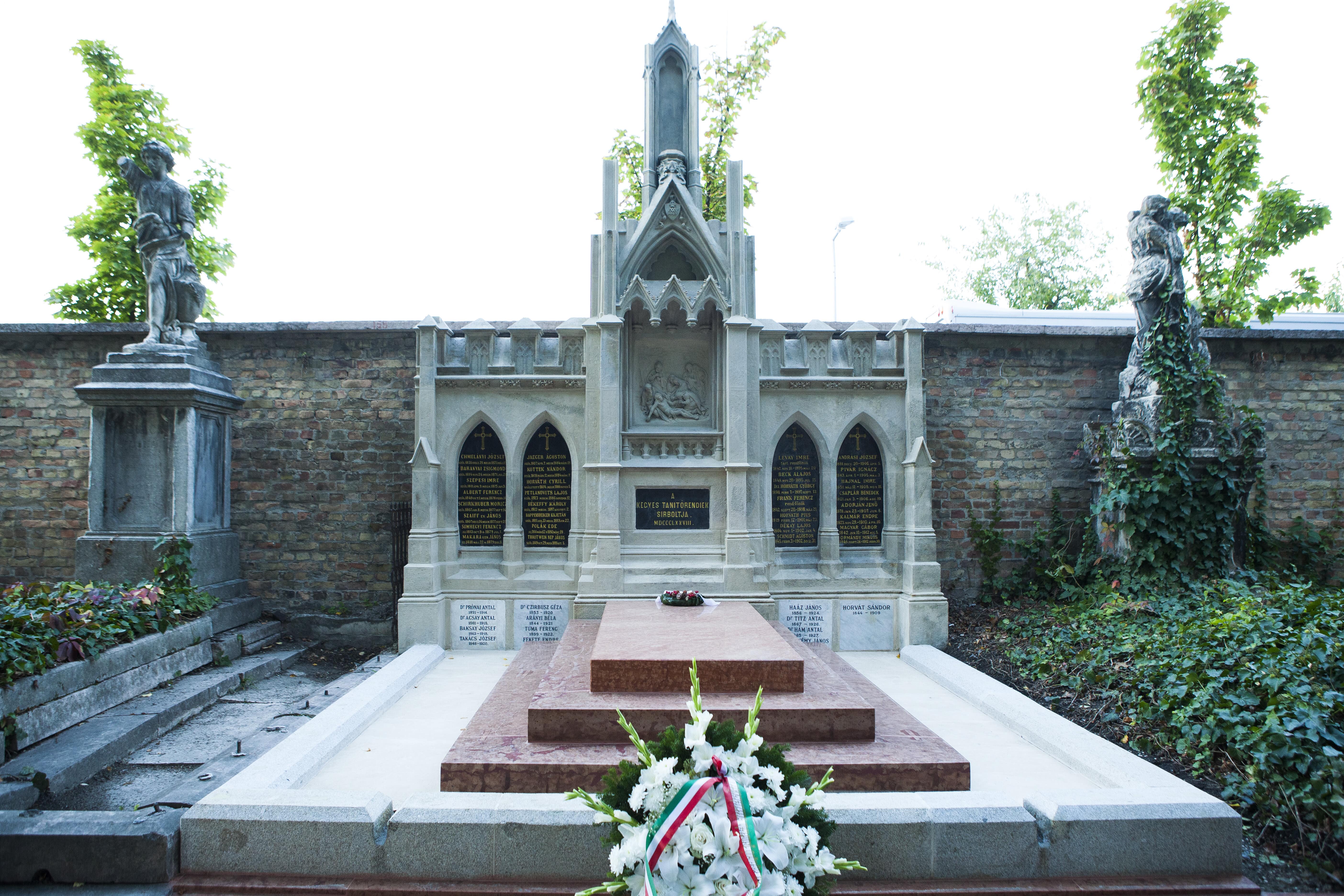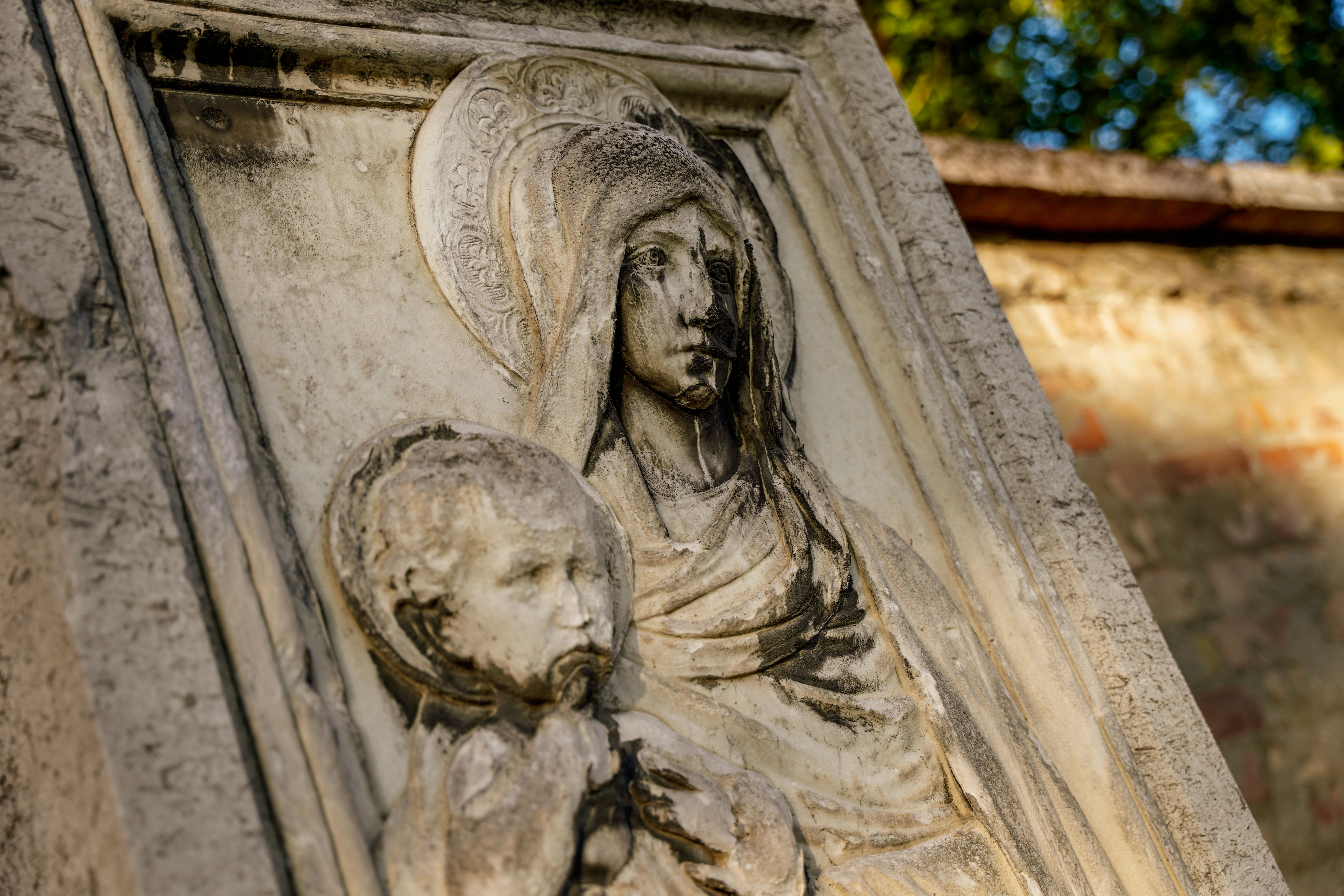
Bal falsírbolt
Szeplőtelen Szűz Mária szobra, A Kunhalmi Rósa család síremléke, vasöntvény, az 1900-as évek eleje (falsírbolt, bal 205)
 A temetőben több olyan síremlék is található, amelyek más híres alkotások alapján, azok másolataként készültek. Ezek általában népszerű festmények kő- vagy bronzdombormű másolatai, közismert szobrok márvány vagy öntvény replikái.
A temetőben több olyan síremlék is található, amelyek más híres alkotások alapján, azok másolataként készültek. Ezek általában népszerű festmények kő- vagy bronzdombormű másolatai, közismert szobrok márvány vagy öntvény replikái.
A Rósa család falsírboltjának sírszobra a Rómában található Maria Immaculata (Szeplőtelen Szűz Mária)-szobor replikája, amelynek eredetijét Guiseppe Obici (1807–1878) készítette 1858-ban. A római katolikus egyház régi időtől kezdve hitte, hogy Mária szeplőtelenül, azaz eredendő bűn nélkül fogant édesanyja méhében. Ezt a tant dogmává azonban csak IX. Piusz pápa emelte 1854. december 8-án. Ennek tiszteletére készítette el az olasz szobrász a Mária Immaculata-szobrot, amely Róma egyik emblematikus alkotásainak egyikévé vált. A korinthoszi oszlop tetején elhelyezett Istenanya földgömbön áll holdsarlóval, lábával a bűnt jelképező kígyót tapossa. A glóbuszt a négy evangélista jelképe, az angyal (Máté), a bika (Lukács), az oroszlán (Márk) és a sas (János) öleli körbe. A Rósa család kriptájának síremlékeként az 1900-as évek elején állították fel.
A piaristák régi sírboltja, 1878 (falsírbolt, bal 155)
Építész: Gottgeb Antal
A kegyes tanítórend régi sírboltja a temető baloldali falsírboltjainak egyikében létesült, számos neves piarista tudós és tanár nyughelye. A különleges szépségű, reprezentatív  síremléket Gottgeb Antal építőmester emelte 1878-ban, neogótikus stílusban. A középkori szárnyas oltárokat idéző építmény tornyai közötti oromzati fülkében eredetileg Szűz Mária szobra állt, amely sajnos mára már elveszett. Az alatta található fülkében Krisztus sírbatételének domborműve látható. A homlokzat középső csúcsívébe a piarista rend Mária-monogramos címere került: a címerpajzsban Szűz Mária monogramját alkotó, egymásba fonódó M és A betűk, kereszttel ékesített korona, és a görög MP ΘY betűk, a Métér Theou (Isten Anyja) szavak nagybetűs rövidítése látható. Az építmény kétoldali „szárnyának” fülkéiben az elhunytak neve olvasható.
síremléket Gottgeb Antal építőmester emelte 1878-ban, neogótikus stílusban. A középkori szárnyas oltárokat idéző építmény tornyai közötti oromzati fülkében eredetileg Szűz Mária szobra állt, amely sajnos mára már elveszett. Az alatta található fülkében Krisztus sírbatételének domborműve látható. A homlokzat középső csúcsívébe a piarista rend Mária-monogramos címere került: a címerpajzsban Szűz Mária monogramját alkotó, egymásba fonódó M és A betűk, kereszttel ékesített korona, és a görög MP ΘY betűk, a Métér Theou (Isten Anyja) szavak nagybetűs rövidítése látható. Az építmény kétoldali „szárnyának” fülkéiben az elhunytak neve olvasható.
Rátzky János család síremléke, márvány, bal 170
Szobrász: ismeretlen
 A síremlék domborműve Antoine Auguste Ernest Hébert (1817–1908) francia festőművész 1872-ben készített festménye alapján készült. A sírdombormű alapjául egy nagyméretű oltárkép szolgált, amelyet először a párizsi Szalonban állítottak ki, aztán a művész szülőhelyének templomában, La Tronche-ban, ahol a mai napig is megtekinthető.
A síremlék domborműve Antoine Auguste Ernest Hébert (1817–1908) francia festőművész 1872-ben készített festménye alapján készült. A sírdombormű alapjául egy nagyméretű oltárkép szolgált, amelyet először a párizsi Szalonban állítottak ki, aztán a művész szülőhelyének templomában, La Tronche-ban, ahol a mai napig is megtekinthető.
A festőművész, aki Rómában a Francia Akadémia igazgatója volt, a porosz–francia háború idején fogadalmat tett, hogy ha szülőfaluja megmenekül a pusztulástól, hálája jeléül megfesti a szent Szüzet gyermekével. S bár Franciaország kapitulált, a poroszok nem jutottak el falujáig, ezért munkához is látott a művész. Az elkészült festményt, amelynek a „Szabadító Szűz”címet adta, korábbi ígérete szerint odaajándékozta a Saint Ferjus templomnak. A képnek egy másik korabeli változata is ismert, amit a Hébert Múzeumban őriznek. A festmény népszerűségét jelzi, hogy a témáját számos másolatban és művészi dekorációban felhasználták.
Jelenlegi ismereteink alapján sajnos azt nem tudjuk, hogy a síremléket milyen motiváció alapján díszíti a festmény domborműváltozata, és hogy pontosan mikor készült.
Statue of the Immaculate Virgin Mary, tomb of the Rósa Kunhalmi family, cast iron, early 1900s (wall tomb, left 205)
 The cemetery has several tombs made on the basis of famous works, that is, as copies. These are, in general, stone or bronze relief duplicates of paintings, marble or cast replicas of well-known statues.
The cemetery has several tombs made on the basis of famous works, that is, as copies. These are, in general, stone or bronze relief duplicates of paintings, marble or cast replicas of well-known statues.
The funerary statue in the Rósa family wall tomb is a replica of the Maria Immaculata in Rome. The original was made by Guiseppe Obici (1807–1878) in 1858. From the very earliest times, the Roman Catholic church had believed that Mary conceived in an immaculate state, preserved from all original sin. However, this doctrine only became dogma in a bull proclaimed by Pope Pius IX on 8 December 1854. The Italian sculptor made his Maria Immaculata statue as a mark of respect and it quickly became one of the iconic works of art in Rome. The Mother of God located at the top of a Corinthian column stands on a globe with crescent moon, crushing a serpent, symbol of sin, beneath her feet. The globe is ringed by the symbols of the four Evangelists, the angel for St. Matthew, the ox for St. Luke, the lion for St. Mark and the eagle for St. John. The crypt of the Rósa family was inaugurated as a tomb in the early 1900s.
Grave of the János Rátzky family, marble, left 170
Sculptor: unknown
 The relief on the grave was made on the basis of a work by French painter Antoine Auguste Ernest Hébert (1817–1908) dating from 1872. The tomb relief is patterned on a large altarpiece, which was first exhibited in the Paris Salon and then later in the church of the artist’s birthplace, La Tronche, where it can still be seen today.
The relief on the grave was made on the basis of a work by French painter Antoine Auguste Ernest Hébert (1817–1908) dating from 1872. The tomb relief is patterned on a large altarpiece, which was first exhibited in the Paris Salon and then later in the church of the artist’s birthplace, La Tronche, where it can still be seen today.
The painter, who was director of the French Academy in Rome, made a vow during the Prussian-French war that if his birthplace escaped unharmed he would, as an expression of his gratitude, paint the Virgin Mary and child. And although France capitulated, the Prussians never made it to the village and thus the artist set to work. In accordance with his earlier vow, he donated the finished painting, which he called the ‘Virgin Saviour’, to the Church of Saint Ferjus. There is another contemporary copy of the picture preserved in the Hébert Museum. An indication of the popularity of the painting is that the subject was used in numerous copies and artistic decorations.
Unfortunately, with our present understanding we still do not know the motivation for decorating the grave with this relief version of the painting, nor do we know when it was made.
Vissza a szoborpark listára